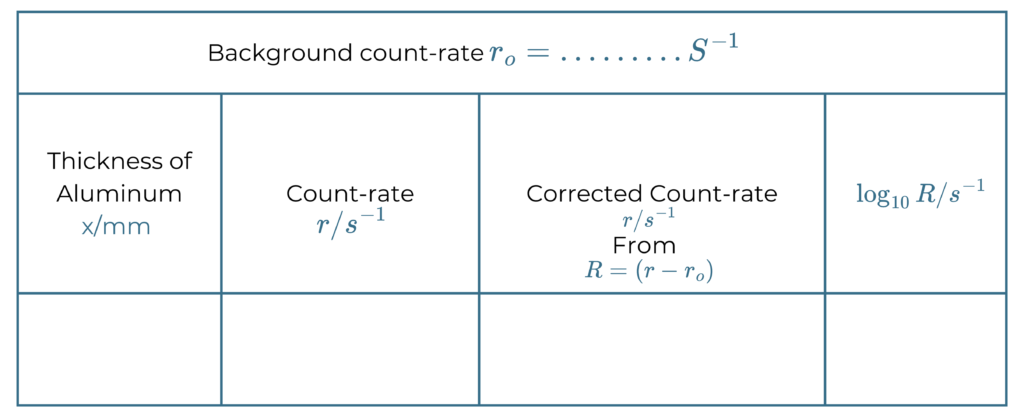Scattering of Beta Particles By Solids
Content of this page :
1. Introduction of the experiment.
2. Aim of the experiment.
3. Tools of the experiment.
4. Steps and methods of the experiment.
5. Parameter of the experiment.
6. Table of The Readings.
7. Medical application and advantages of the experiment.
1. Introduction of the experiment:
The study of the scattering of beta particles by solids, particularly focusing on absorption in aluminum and back-scattering by different materials, is a critical area of research in nuclear physics and materials science. Beta particles are high-energy electrons or positrons emitted during radioactive decay processes, and their interaction with solid materials provides valuable insights into particle behavior and material properties.
2. Aim of the experiment:
-Absorption In Aluminum.
-Back-Scattering By Different Materials.

3-Tools of The experiment
- G-M tube (MX168 or 168 /01) on supporting stand. Scaler or ratemeter with appropriate e.h.t supply (250-500 V). Sealed beta source and forceps for handling. Set of aluminum foils. Micrometer gauge, lead screen.
4. Steps and methods of the experiment:
1-Absorption in aluminum:
Connect the G-M tube to the appropriate socket of the scaler or ratemeter and then do not again move the G-M tube during the course of the experiment. Switch on, allow the instrument to warm up and then um Set the e.h.t. to the appropriate operating voltage marked on the tube (or as determined in Experiment 85). Measure and record the background count-rate (with a scaler, take counts over periods of 100 seconds; with ratemeter, an integrating time of 25 seconds). Using forceps place the beta source in its supporting base and adjust its distance from the window of the G-M tube so that a high count-rate is observed. Record this count-rate. Measure the thickness of the thinnest aluminum foil with the micrometer gauge, place it between the source and the G-M tube and record the count-rate. Take further readings of the count-rate as successive aluminum foils of measured total thickness are placed in position.
2-Back-scattering by different materials:
Place the G-M tube, a lead screen and the beta source on the same side of a chalk line HK drawn on the bench. Measure the initial count-rate. Now place successive slabs of different materials (lead, copper, iron, aluminum, carbon) in the same position on HK and observe the effect on the count- rate. Investigate how the back-scattering depends on the thickness of the scattering material and also how it depends on the atomic number of the scattering element.
5-Parameter of The Experiment:
The absorption of beta particles by matter is approximately exponential, being expressed in the form:

Where lo is the initial intensity of the radioactive radiation, I the intensity after traversing a thickness of material x and μ is a constant called the linear absorption coefficient of the material.
Since:

Therefore:

Taking logs to the base 10 and rearranging:

From (2) and the slope of the graph:
Slope

Therefore linear absorption coefficient

6. Table of the Readings:

7-Medical application
Radiation Shielding and Safety:
- Application: Hospitals and medical facilities use radiation shielding to protect staff, patients, and the public from ionizing radiation emitted during medical procedures such as X-ray imaging and radiation therapy.
- Use of Aluminum (Absorption): Understanding how beta particles are absorbed by aluminum helps in designing effective shielding materials. Aluminum’s ability to attenuate beta radiation can influence the construction of protective barriers and equipment used in radiation therapy rooms and imaging facilities.
- Use of Different Materials (Back-Scattering): Knowledge of how different materials scatter or reflect beta particles assists in designing shielding barriers and protective clothing. This ensures minimal exposure to medical personnel working with radioactive materials or patients undergoing treatments involving beta-emitting isotopes.
Radiation Therapy:
- Application: Beta-emitting isotopes like phosphorus-32 (P-32) and yttrium-90 (Y-90) are used in radiation therapy to treat various cancers, such as ocular melanoma and certain types of lymphoma.
- Use of Aluminum (Absorption): Assessing how aluminum absorbs beta particles helps in optimizing treatment delivery. Understanding the material’s absorption properties ensures precise dosimetry calculations and effective localization of radiation to target tumors while sparing healthy tissues.
- Use of Different Materials (Back-Scattering): Materials that scatter beta particles can be used in applicators or shields to shape and control the radiation beam during therapy. This technique enhances treatment accuracy and minimizes collateral damage to surrounding healthy tissues.
Radiation Dosimetry and Monitoring:
- Application: Accurate measurement and monitoring of radiation doses are critical in radiation oncology and diagnostic imaging procedures.
- Use of Aluminum (Absorption): Aluminum is used in calibration phantoms and dosimeters to measure beta particle energies and doses received by patients during treatments. Understanding how beta particles interact with aluminum aids in calibrating dosimeters for accurate radiation dose assessment.
- Use of Different Materials (Back-Scattering): Materials that back-scatter beta particles are employed in detectors and monitors to measure radiation levels in medical environments. This ensures compliance with safety standards and enhances radiation protection for healthcare workers and patients.
Radiopharmaceutical Development:
- Application: Beta-emitting radiopharmaceuticals are used in diagnostic imaging (e.g., PET scans) and targeted radionuclide therapy (e.g., lutetium-177 DOTATATE for neuroendocrine tumors).
- Use of Aluminum (Absorption): Studying how beta particles interact with aluminum containers or packaging is crucial for radiopharmaceutical safety and storage. Aluminum’s absorption characteristics help in minimizing radiation exposure during handling and transportation.
- Use of Different Materials (Back-Scattering): Materials that back-scatter beta particles can influence the design of radiopharmaceutical containers and shielding. This ensures safe handling and administration of radiopharmaceuticals while minimizing radiation exposure to healthcare providers and patients.
